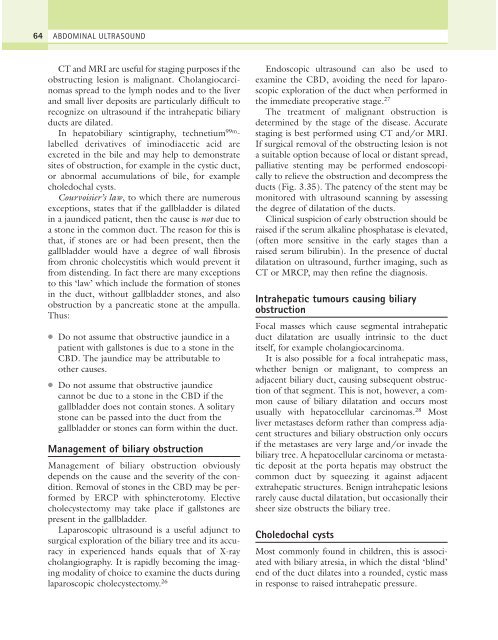9%20ECOGRAFIA%20ABDOMINAL%20COMO%20CUANDO%20DONDE
Create successful ePaper yourself
Turn your PDF publications into a flip-book with our unique Google optimized e-Paper software.
64<br />
ABDOMINAL ULTRASOUND<br />
CT and MRI are useful for staging purposes if the<br />
obstructing lesion is malignant. Cholangiocarcinomas<br />
spread to the lymph nodes and to the liver<br />
and small liver deposits are particularly difficult to<br />
recognize on ultrasound if the intrahepatic biliary<br />
ducts are dilated.<br />
In hepatobiliary scintigraphy, technetium 99m -<br />
labelled derivatives of iminodiacetic acid are<br />
excreted in the bile and may help to demonstrate<br />
sites of obstruction, for example in the cystic duct,<br />
or abnormal accumulations of bile, for example<br />
choledochal cysts.<br />
Courvoisier’s law, to which there are numerous<br />
exceptions, states that if the gallbladder is dilated<br />
in a jaundiced patient, then the cause is not due to<br />
a stone in the common duct. The reason for this is<br />
that, if stones are or had been present, then the<br />
gallbladder would have a degree of wall fibrosis<br />
from chronic cholecystitis which would prevent it<br />
from distending. In fact there are many exceptions<br />
to this ‘law’ which include the formation of stones<br />
in the duct, without gallbladder stones, and also<br />
obstruction by a pancreatic stone at the ampulla.<br />
Thus:<br />
●<br />
●<br />
Do not assume that obstructive jaundice in a<br />
patient with gallstones is due to a stone in the<br />
CBD. The jaundice may be attributable to<br />
other causes.<br />
Do not assume that obstructive jaundice<br />
cannot be due to a stone in the CBD if the<br />
gallbladder does not contain stones. A solitary<br />
stone can be passed into the duct from the<br />
gallbladder or stones can form within the duct.<br />
Management of biliary obstruction<br />
Management of biliary obstruction obviously<br />
depends on the cause and the severity of the condition.<br />
Removal of stones in the CBD may be performed<br />
by ERCP with sphincterotomy. Elective<br />
cholecystectomy may take place if gallstones are<br />
present in the gallbladder.<br />
Laparoscopic ultrasound is a useful adjunct to<br />
surgical exploration of the biliary tree and its accuracy<br />
in experienced hands equals that of X-ray<br />
cholangiography. It is rapidly becoming the imaging<br />
modality of choice to examine the ducts during<br />
laparoscopic cholecystectomy. 26<br />
Endoscopic ultrasound can also be used to<br />
examine the CBD, avoiding the need for laparoscopic<br />
exploration of the duct when performed in<br />
the immediate preoperative stage. 27<br />
The treatment of malignant obstruction is<br />
determined by the stage of the disease. Accurate<br />
staging is best performed using CT and/or MRI.<br />
If surgical removal of the obstructing lesion is not<br />
a suitable option because of local or distant spread,<br />
palliative stenting may be performed endoscopically<br />
to relieve the obstruction and decompress the<br />
ducts (Fig. 3.35). The patency of the stent may be<br />
monitored with ultrasound scanning by assessing<br />
the degree of dilatation of the ducts.<br />
Clinical suspicion of early obstruction should be<br />
raised if the serum alkaline phosphatase is elevated,<br />
(often more sensitive in the early stages than a<br />
raised serum bilirubin). In the presence of ductal<br />
dilatation on ultrasound, further imaging, such as<br />
CT or MRCP, may then refine the diagnosis.<br />
Intrahepatic tumours causing biliary<br />
obstruction<br />
Focal masses which cause segmental intrahepatic<br />
duct dilatation are usually intrinsic to the duct<br />
itself, for example cholangiocarcinoma.<br />
It is also possible for a focal intrahepatic mass,<br />
whether benign or malignant, to compress an<br />
adjacent biliary duct, causing subsequent obstruction<br />
of that segment. This is not, however, a common<br />
cause of biliary dilatation and occurs most<br />
usually with hepatocellular carcinomas. 28 Most<br />
liver metastases deform rather than compress adjacent<br />
structures and biliary obstruction only occurs<br />
if the metastases are very large and/or invade the<br />
biliary tree. A hepatocellular carcinoma or metastatic<br />
deposit at the porta hepatis may obstruct the<br />
common duct by squeezing it against adjacent<br />
extrahepatic structures. Benign intrahepatic lesions<br />
rarely cause ductal dilatation, but occasionally their<br />
sheer size obstructs the biliary tree.<br />
Choledochal cysts<br />
Most commonly found in children, this is associated<br />
with biliary atresia, in which the distal ‘blind’<br />
end of the duct dilates into a rounded, cystic mass<br />
in response to raised intrahepatic pressure.



